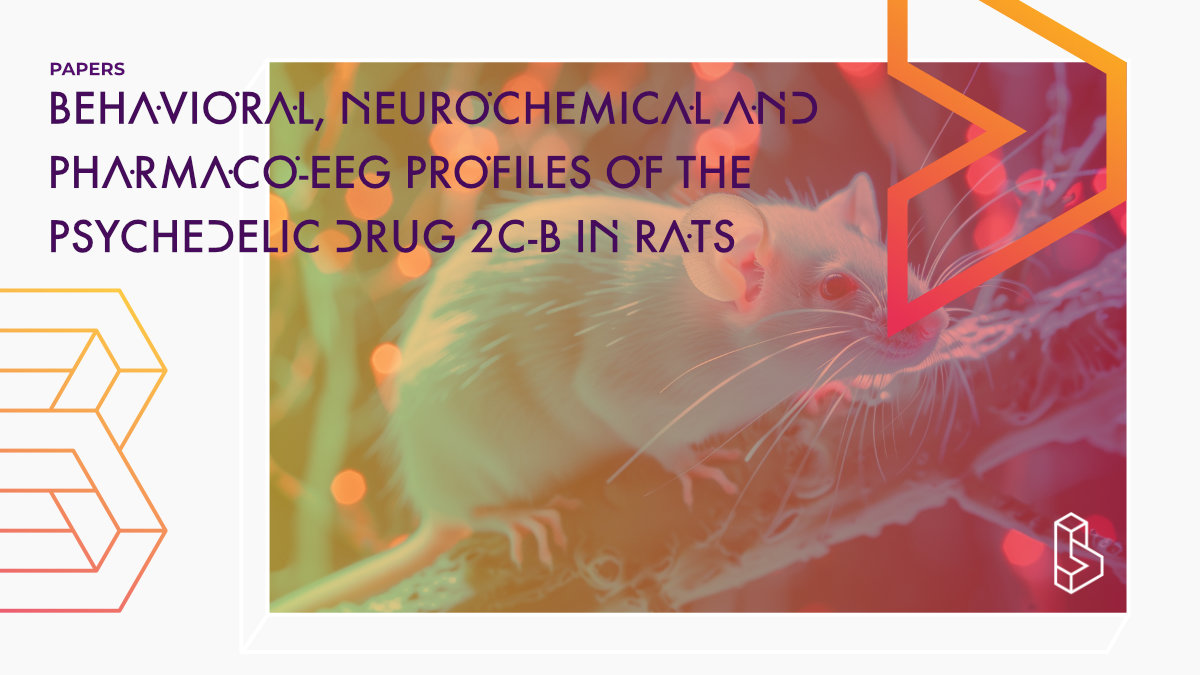This experimental study investigates the behavioral, neurochemical, and EEG profiles 2C-B in rats. 2C-B demonstrates biphasic effects on locomotion, initially inhibitory and then excitatory, contrasting with amphetamine which induces solely hyperlocomotion. Both compounds disrupt prepulse inhibition (PPI) of the startle reaction, albeit with different effects on acoustic startle response (ASR). In the nucleus accumbens (NAc), 2C-B increases dopamine levels but decreases 3,4-dihydroxyphenylacetic acid (DOPAC), suggesting potential psychotomimetic and addictive properties. EEG analyses reveal that low doses of 2C-B reduce power spectra and coherence, whereas high doses show biphasic effects on EEG power and coherence.
Abstract of Behavioral, neurochemical and pharmaco-EEG profiles of the psychedelic drug 4-bromo-2, 5-dimethoxyphenethylamine (2C-B) in rats
“Rationale and objectives: Behavioral, neurochemical and pharmaco-EEG profiles of a new synthetic drug 4-bromo-2,5-dimethoxyphenethylamine (2C-B) in rats were examined.
Materials and methods: Locomotor effects, prepulse inhibition (PPI) of acoustic startle reaction (ASR), dopamine and its metabolite levels in nucleus accumbens (NAc), EEG power spectra and coherence in freely moving rats were analysed. Amphetamine was used as a reference compound.
Results: 2C-B had a biphasic effect on locomotion with initial inhibitory followed by excitatory effect; amphetamine induced only hyperlocomotion. Both drugs induced deficits in the PPI; however they had opposite effects on ASR. 2C-B increased dopamine but decreased 3,4-dihydroxyphenylacetic acid (DOPAC) in the NAc. Low doses of 2C-B induced a decrease in EEG power spectra and coherence. On the contrary, high dose of 2C-B 50 mg/kg had a temporally biphasic effect with an initial decrease followed by an increase in EEG power; decrease as well as increase in EEG coherence was observed. Amphetamine mainly induced an increase in EEG power and coherence in theta and alpha bands. Increases in the theta and alpha power and coherence in 2C-B and amphetamine were temporally linked to an increase in locomotor activity and DA levels in NAc.
Conclusions: 2C-B is a centrally active compound similar to other hallucinogens, entactogens and stimulants. Increased dopamine and decreased DOPAC in the NAc may reflect its psychotomimetic and addictive potential and monoaminoxidase inhibition. Alterations in brain functional connectivity reflected the behavioral and neurochemical changes produced by the drug; a correlation between EEG changes and locomotor behavior was observed.”
Authors: Tomáš Páleníček, Michaela Fujáková, Martin Brunovský, Jiří Horáček, Ingmar Gorman, Marie Balíková, Lukáš Rambousek, Kamila Syslová, Petr Kačer, Petr Zach, Věra Bubeníková-Valešová, Filip Tylš, Anna Kubešová, Jana Puskarčíková & Cyril Höschl
Summary of Behavioral, neurochemical and pharmaco-EEG profiles of the psychedelic drug 4-bromo-2, 5-dimethoxyphenethylamine (2C-B) in rats
4-Bromo-2,5-dimethoxyphenethylamine (2C-B, desmethyl-DOB or Nexus) is a phenylethylamine derivative with psychedelic/entactogenic* effects in humans and is abused under similar conditions as the recreational drug ecstasy (3,4-methylenedioxymethamphetamine, MDMA). In spite of its popularity among recreational drug users, there is a substantial lack of evidence about 2C-B’s behavioral effects and mechanisms of action in scientific literature. It is likely to act as a partial agonist on serotonin 5-HT2A/C and 5-HT1A/B receptors. We studied 2C-B’s effects in rats using behavior, dopamine neurotransmission and quantitative EEG. Amphetamine was used as a comparative drug to differentiate empathogenic/entactogenic and/or hallucinogenic effects. We measured levels of dopamine and its metabolites in the nucleus accumbens (NAc), which is involved in stimulatory effects of drugs, in the regulation of sensorimotor gating and is related to addictive potential of drugs. 2C-B’s reported mixed entactogenic/psychedelic properties lead us to a thesis that it would induce comparable changes to MDMA.
2C-B was evaluated on quantitative EEG by recording from 12 active cortical electrodes simultaneously in rats. This technique is more translational to human recording conditions and provides important added value of these experiments.
Materials and methods
Find this paper
https://doi.org/10.1007/s00213-012-2797-7
Paywall | Google Scholar | Backup | 🕊
Cite this paper (APA)
Páleníček, T., Fujáková, M., Brunovský, M., Horáček, J., Gorman, I., Balíková, M., ... & Höschl, C. (2013). Behavioral, neurochemical and pharmaco-EEG profiles of the psychedelic drug 4-bromo-2, 5-dimethoxyphenethylamine (2C-B) in rats. Psychopharmacology, 225, 75-93.

